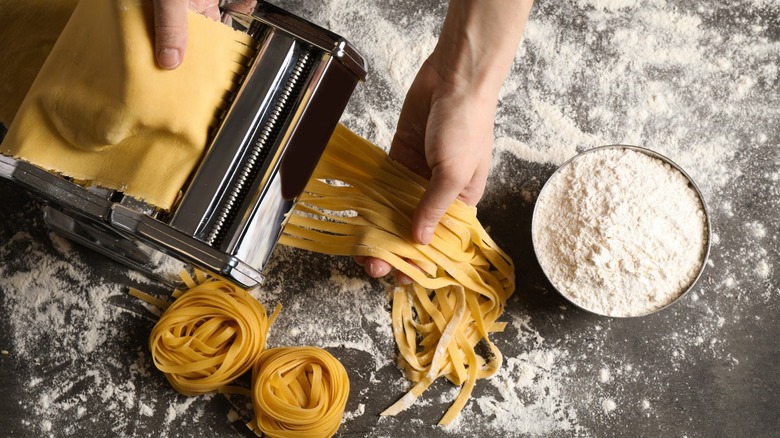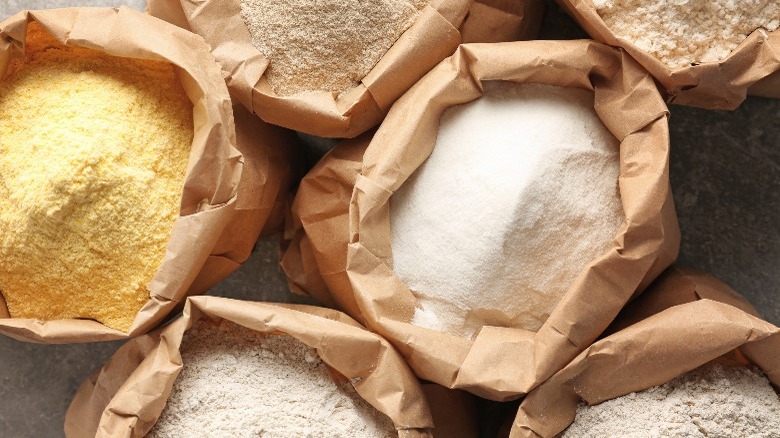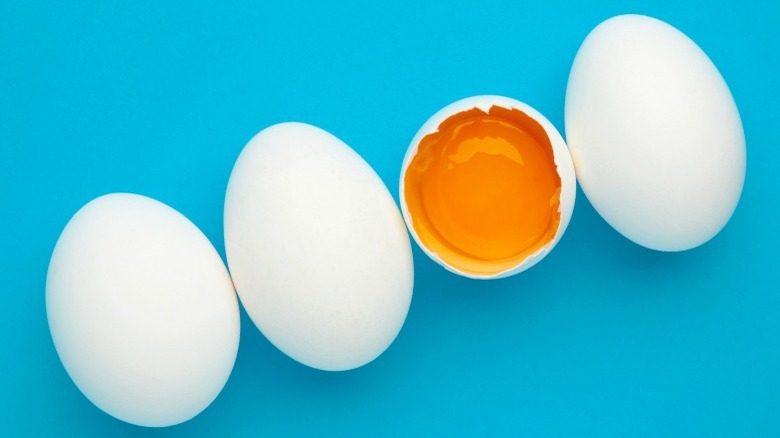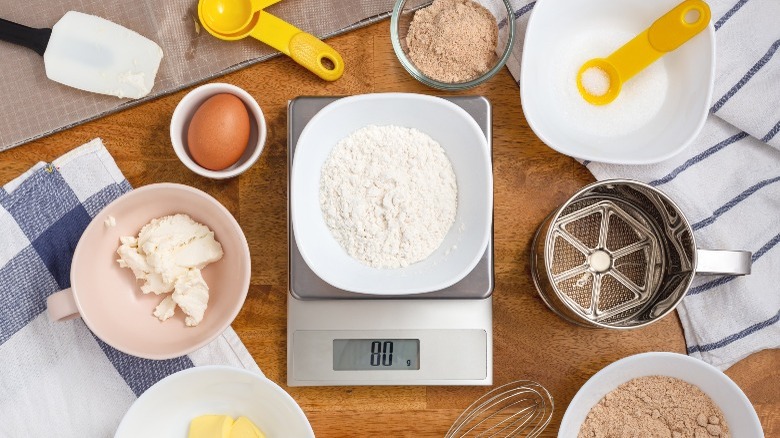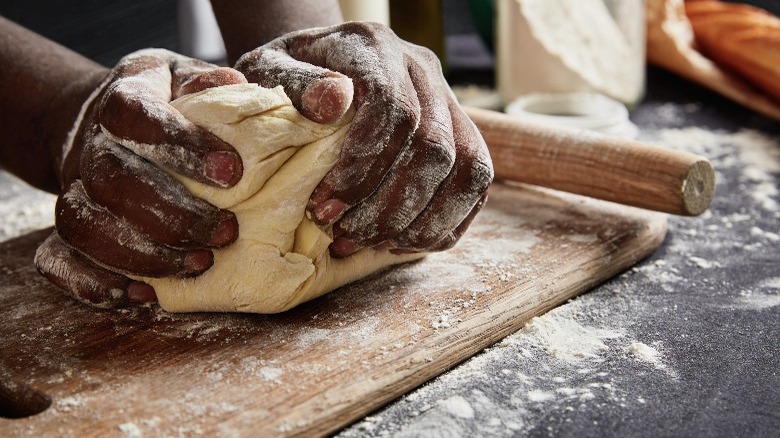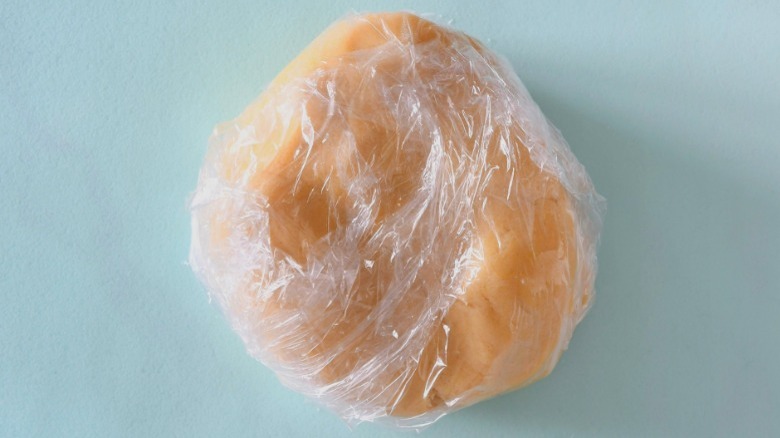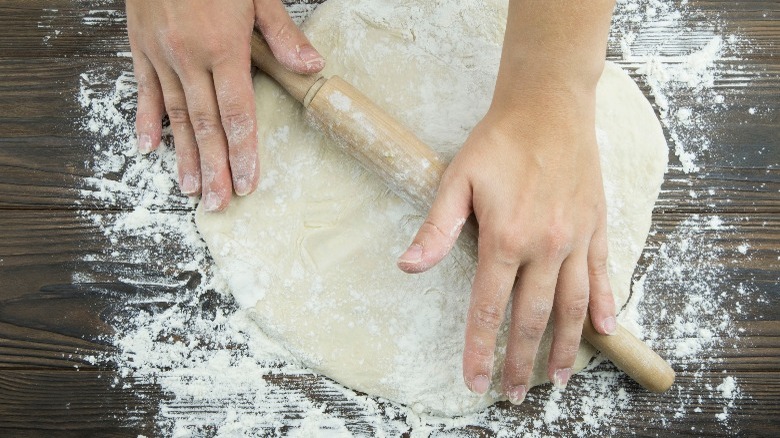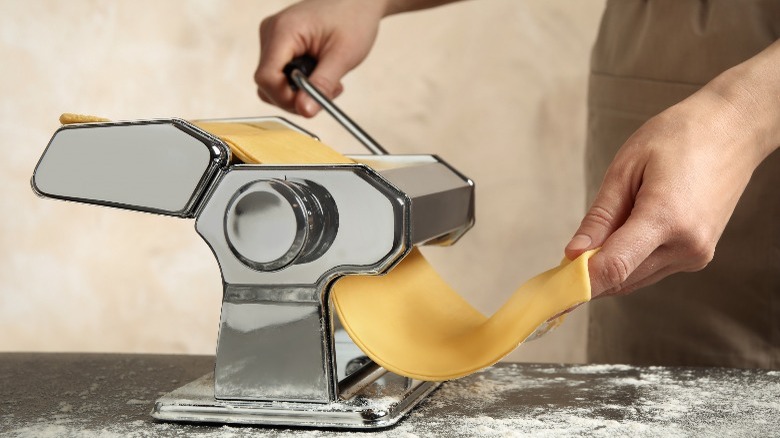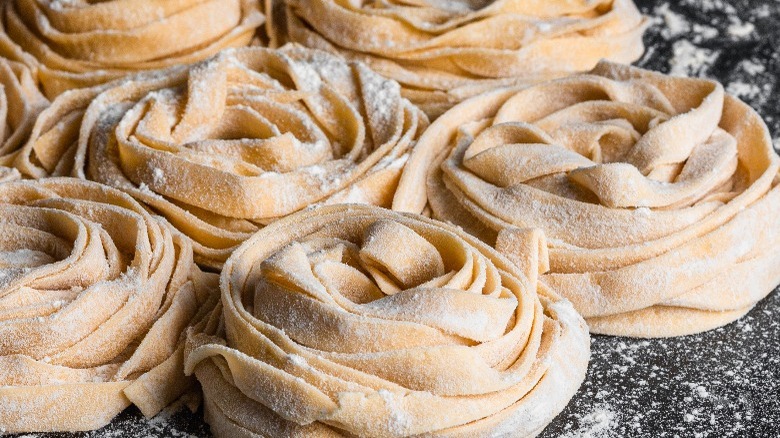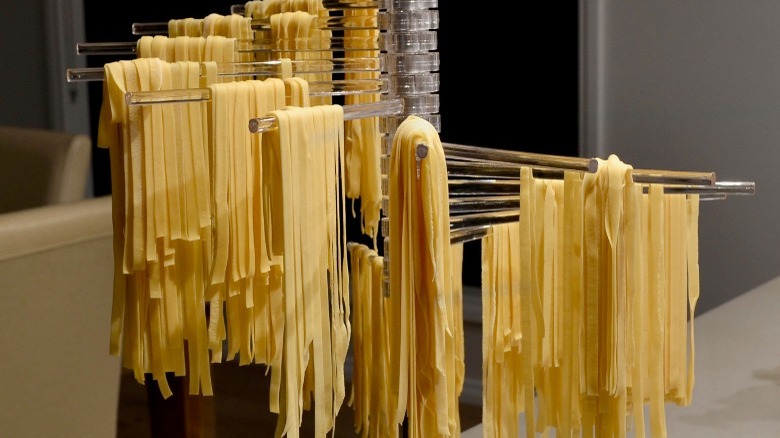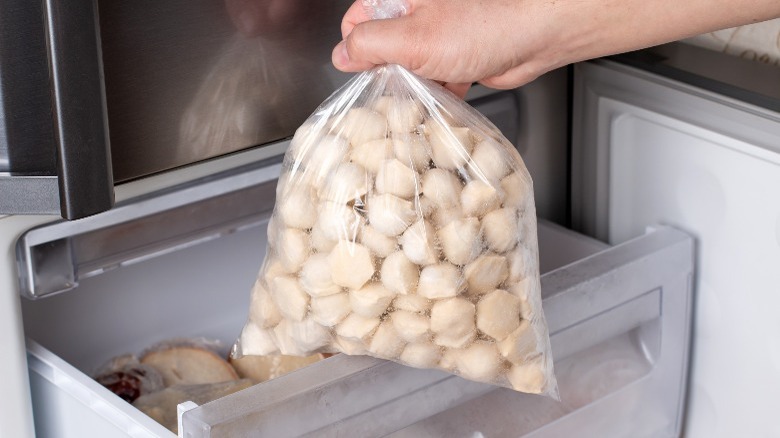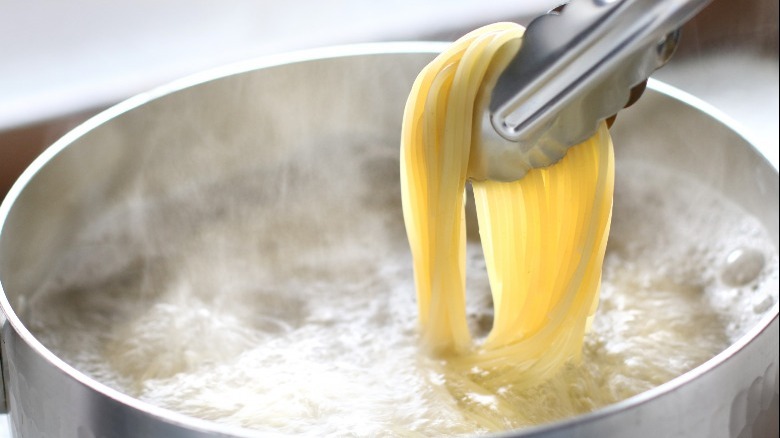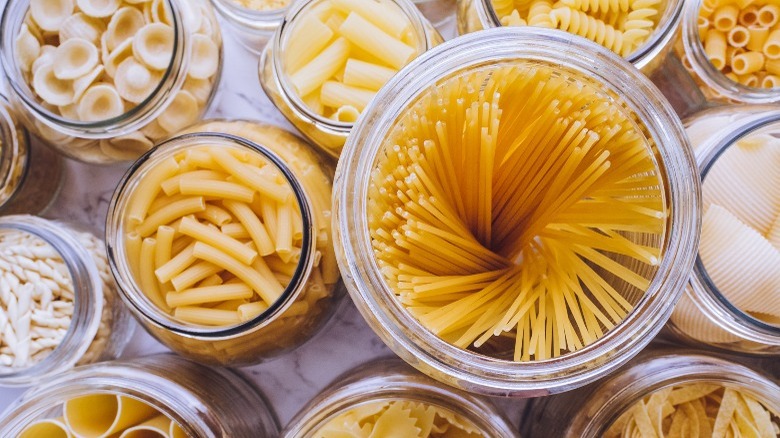Mistakes Everyone Makes With Fresh Pasta
The Italians have a saying: "La farina del diavolo va in crusca." Translation: The devil's flour turns to chaff. Essentially, if you're going to do something, you should do it right. As Oscar winner and "Flavor of Love Girls: Charm School" host Mo'Nique says, "When you do clownery, the clown comes back to bite." Don't do clownery. And never, under any circumstances, use the devil's flour to make fresh pasta.
Even if you don't keep the devil's flour in your pantry, a lot can go wrong when making pasta from scratch. But don't let that deter you: Fresh pasta is a thing of beauty, offering a toothsome and satisfying bite that dry pasta can't possibly replicate. The process, from kneading to rolling to cutting, can even be fun, and it's totally worth the effort — just be sure to avoid these common mistakes. You'll be a pasta pro in no time, the devil and his flour be damned.
Using the wrong type of flour
All-purpose flour is acceptable for making pasta (hence the name). But for the real deal, the Italians have a couple different types of flour that are especially suitable for their most famous dish. They're quite different in texture, but they serve distinct purposes.
The first flour commonly used is known as doppio zero or 00 flour. The zeroes refer to the degree that the grain has been ground, according to Fabulous Pasta, and 00 flour is the finest of the bunch. This leads to a smooth, silky noodle with a soft bite. The other flour, semolina flour, is considerably coarser than the 00 variety, creating a more rugged pasta. This roughness is perfect for picking up hearty sauces. Semolina dough is also less elastic, which is helpful in allowing extruded pastas like rigatoni keep their shape.
Any pasta dough made with eggs can use solely 00 flour or a combination of 00 and semolina flour. The more semolina used, the more textured the pasta. If opting for an eggless pasta, you can use just semolina and water; a finer flour will have a hard time forming a dough with water as its only binding agent.
Not adding eggs (or... adding eggs) to your pasta dough
There are two main components to pasta dough: flour and liquid. As discussed, there are multiple types of the former you can use. Similarly, the liquid can take different forms, with some more appropriate than others based on the type of pasta you plan to make. Therein lies the question: To egg or not to egg?
In egg pasta, the yolks' fat content adds an unctuous, rich quality to the noodle, and also gives the dough its golden hue. The egg whites provide water content and additional protein (which helps give the pasta strength), but too much egg white can lead to too much water in the dough. For this reason, Meryl Feinstein of Pasta Social Club opts for a combination of egg yolks and whole eggs (via Food52). Egg pasta is great for rolling out into long strands and sheets for stuffed pasta like ravioli.
Meanwhile, a dough made with just semolina flour and water (no eggs) will give you a product that's tougher and therefore easier to form into pasta shapes, according to Inside the Rustic Kitchen. Strascinati (dragged pastas) such as orecchiette and cavatelli are a staple in Southern Italian kitchens and come together with this simple, two-ingredient dough.
Not measuring ingredients by weight
Pasta dough is beautiful in its simplicity: Just a few ingredients come together to provide a whole lot of carby goodness. But what distinguishes sub-par pappardelle from far-out farfalle is precision. Ensuring the proper hydration level of pasta dough is critical in yielding an ideal texture, flavor, and shape; a study from the University of Milan's Department of Food and Nutritional Sciences backs this up (via MDPI). The most effective way to do this: measuring your ingredients by weight, not volume.
Think about it. If you measure a cup of flour and really pack it in there, you'll end up with more flour than someone scooping from a pile of freshly sifted (i.e. light and airy) flour. Taste of Home's informal experiment showed that staffers tasked with measuring out one cup of flour wound up with amounts anywhere from 3 ounces to 5 ½ ounces (for what it's worth, the proper weight of a cup of flour should be 4 ¼ ounces).
Pasta Social Club says a kitchen scale is the surest way to get just the amount of dry and wet ingredients. The company's blog recommends a 3:4 liquid-flour ratio (again, by weight) if using eggs and 00 flour or a 1:2 liquid-flour ratio if using water and semolina.
Not kneading the pasta dough enough
Once the flour and liquid are combined, we need to knead. Kneading not only allows the dough to take shape, but it also helps the dough develop its network of gluten, the protein that gives pasta and other doughs their structure and elasticity (via Serious Eats). Just because the dough is combined doesn't mean it's time to stop kneading; that dough still needs more gluten.
Let your palm do most of the work, pressing into the ball in a down-and-forward motion. Fold, rotate 45 degrees, and repeat. It will get tougher as you go along, but that just means the gluten network is doing its job. Serious Eats' method calls for kneading the dough this way for about 10 minutes, until you're left with an extremely smooth ball that resembles firm Play-Doh.
The good news is it's nearly impossible to knead pasta dough too much — only too little. And if you'd rather skip arm day, you can use a stand mixer with a dough hook attachment (just keep it on low).
The dough hasn't rested enough
Congratulations: Your dough is kneaded and your arm is probably a little sore. But before you can get to rolling out your freshly made pasta into sheets, that dough needs to rest for a bit — you did just put it through quite the workout. Epicurious likens this step to hitting the steam room at the gym; the dough just got swole developing those gluten networks, so it needs to unwind to become elastic. Otherwise, it'll tense up and you'll risk a tear when moving on to your next workout (the rolling phase).
During this period, make sure the ball of dough is wrapped tightly in plastic wrap to prevent it from drying out. The resting time depends on the hydration level of your dough, and frankly, who you ask. Food Network favorite Anne Burrell suggests a one-hour rest period. Evan Funke, restaurateur and author of the cookbook "American Sfoglino," has his rest for at least two to three hours (via Epicurious). After an hour, give your dough a test. Roll out a small piece; if it's rubbery and immediately starts to bounce back, give it some more time. If it rolls easily and keeps its shape, you're ready to move on.
Rolling only by hand
Technically speaking, you can make pasta by hand. After all, those Italian nonnas didn't always have fancy pasta rollers and other such gadgets. But here's the thing: If you're reading this, you're probably not an Italian nonna who's already mastered the art of pasta making, and you definitely live in an age where kitchen tools that ensure even, consistent pasta are readily available.
When rolling out pasta dough into sheets — which, if making long noodles, will subsequently get cut into strips — you can start out with a rolling pin. But that alone won't do the trick. To get sheets of pasta as evenly thin as we need, we will need some sort of pasta machine. There are several types available. Some are operated with a hand crank; some are electric. Some clamp to the ledge of your kitchen counter; some are sold as stand mixer accessories. No matter the model you opt for, a pasta machine will drastically reduce your prep time and drastically improve the consistency of the final product, assures Uno Casa.
Not using the roller in phases
So you've gotten yourself a pasta machine. Brava; that's one pasta mistake averted. When using the machine, however, you should follow a few rules to ensure your dough doesn't tear and dash your pasta dreams before the noodles even hit the water.
The first step involves laminating your pasta dough. This allows the dough to continue its gluten development. That gluten development helps give the dough strength, and that strength reduces tears (tears in the dough and tears of frustration). The Spruce Eats' laminating method calls for feeding the dough through the pasta maker on its widest setting (usually the lowest number), then folding the piece into thirds like a business letter and passing it through again on that same setting. This process is repeated four more times.
Once properly laminated, the dough is ready to get thinned out. Each setting on the pasta machine's dial will roll the pasta to a thinner thickness. While it may be tempting to skip settings to save time, don't. Work your way through the numbered settings one at a time, feeding the dough through the machine at each level until you reach the desired thickness. This gradual process will prevent the dough from getting wrinkled or ripping in the machine, according to Seasoned Cooks. You don't have to go to the narrowest setting available on the machine, but just remember that the pasta will thicken a little as it cooks.
Letting the pasta dough oxidize
You know how a sliced apple will start to get brown if you don't eat it fast enough, or how a peeled potato will develop gray streaks if you don't cook it right away? A similar thing can happen with fresh pasta made with eggs. This is due to the iron content in egg yolks, explains Cooks Illustrated, which can cause the dough to turn a greenish gray on the exterior. This can start to happen if noodles are kept uncooked in the fridge for more than 18 hours.
This isn't so much a problem with dough that hasn't been rolled out yet, as the plastic wrap you're keeping it in will prevent air from reaching it, and a ball of dough has considerably less surface area than a bunch of cut noodles or pasta shapes. Still, it's best to use your dough while it is still fresh; this is fresh pasta we're talking about, after all.
The good news it that if your pasta does start to oxidize, it is still safe to eat; that discoloration does not drastically affect the flavor, according to Pasta Evangelists. That said... Who likes a gray pasta?
Letting it clump
Dough likes to stick to itself, and pasta dough is no exception. So when you're making long ribbons of noodles, things can get sticky — literally. Once strands start to clump together, it's basically impossible to pull them apart without damaging their shape. This is why it's especially important to spread pieces of pasta out as soon as they're cut.
There are a couple of tricks that will help with this. The first is an ingredient you have probably already used: semolina. Dusting the individual pieces with the coarse flour immediately after cutting the pasta will help keep them separated, says The Fond Life. (One thing to keep in mind, however: that loose semolina will then be present in your pasta water, so once it's cooked, don't pour the pasta into a colander. Otherwise, you'll get an extra serving of coarse semolina. Gross.) You can also invest in a pasta rack, which will allow you to keep the strands apart and dry them at the same time.
Not making an extra batch
Making pasta from scratch is a labor of love and can be quite the time commitment. So if you're going through the trouble, you might as well double the recipe to make it that much easier the next time you're craving some homemade noodles. Unrolled pasta dough keeps well in the freezer, according to KitchenAid. Once the dough has rested at room temperature for the appropriate amount of time, wrap it tightly in plastic wrap and toss it in the freezer, where it will keep for up to four weeks. Just let it thaw in the refrigerator overnight and you're good to roll.
You can also pre-make your pasta shapes or strands and then freeze. For shapes (orecchiette, cavatelli, etc), arrange in a single layer on a baking sheet dusted with semolina and freeze. Once each piece is individually frozen, toss them into an airtight container or freezer bag. For long pastas (tagliatelle, linguine, etc), KitchenAid recommends spreading out individual strands and letting them dry out for a few minutes before twirling portions into little nests. Allow the nests to dry for about an hour before transferring to a freezer bag or airtight container. No need to thaw frozen pre-cut pasta; it can go right into salted boiling water (just add 30 to 60 seconds to the cooking time, advises the Oakland-based The Pasta Shop).
Cooking the pasta for too long
One of the benefits of cooking with fresh pasta (once you've made it, at least) is its drastically reduced cooking time. Whereas some dried pasta may take as long as 12 minutes to reach al dente (per Food Republic), fresh pasta, according to The Daily Meal, will reach that desirable level of doneness in less than two minutes. Some smaller shapes could take as little as a few seconds before they're ready. Dried pasta is dehydrated pasta; when you're cooking it, you're also rehydrating it. That's not necessary with fresh pasta, as that liquid content is already there with the inclusion of water and/or eggs. Cook fresh pasta for as long as you'd cook the dry kind, and you'll end up with mush.
One guideline you may see when encountering recipes and instructions for fresh pasta is to cook it until it floats to the top of the pot. While this may give you some indication that the pasta is on its way to reaching al dente, that doesn't mean they're entirely done. Home Cook World explains that this rule is reserved for stuffed pastas, where air in the filling can expand, making the ravioli less dense than the water it's cooking in. The pasta itself may not be cooked all the way through even if it's floating, so it's always best to check with a taste; you're looking for a little chewy with a little bite.
Sleeping on dried pasta
Fresh pasta is a special experience, but that doesn't mean that it's inherently better than dried — at least not in all contexts. Dried pasta should still remain a staple in your pantry, even if you love any excuse to whip out that pasta machine.
According to Taste of Home, fresh pasta is best with simpler sauces that will bring out the egginess and chew of the pasta. Preparations like Rome's famous carbonara and cacio e pepe, a delicate pesto, or a simple aglio e olio are good picks. Dried pasta, on the other hand, can withstand heartier sauces, such as a chunky puttanesca or a meat-heavy ragù. It can also take on a longer cook time without losing its structure, which makes it prime for baked dishes and soups.
Of course, there's always an exception to the rule. And here, the exception is bolognese. Epicurious says this particular meaty ragù is actually best with fresh egg pasta. That's because the classic bolognese includes whole milk as an ingredient, which gives the finished product its silky, rich consistency that can stand up to fresh pasta.
